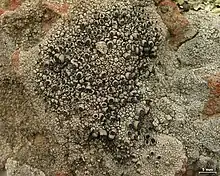Thelomma santessonii
Thelomma santessonii, the tan nipple lichen,[1] is a species of saxicolous (rock-dwelling), crustose lichen in the family Caliciaceae. Found in northern North America, it was formally described as a new species in 1976 by lichenologist Leif Tibell.[2] It is endemic to the coast and islands of Southern California and Baja California in Mexico.[3]
| Thelomma santessonii | |
|---|---|
 | |
| Scientific classification | |
| Domain: | Eukaryota |
| Kingdom: | Fungi |
| Division: | Ascomycota |
| Class: | Lecanoromycetes |
| Order: | Caliciales |
| Family: | Caliciaceae |
| Genus: | Thelomma |
| Species: | T. santessonii |
| Binomial name | |
| Thelomma santessonii Tibell (1976) | |
Thelomma santessonii has a yellowish tan color, and is areolate. The thallus has verrucae that measure up to 2.5 mm (0.10 in) broad. The expected results of chemical spot tests are KC− on the thallus, and K+ (red), P+ (yellow) on the mazaedia. When a long-wavelength UV light is lit on the thallus, it fluoresces a blue-white color. The ascospores of the lichen are spherical and lack any septa; they measure 14–16 μm.[1]
Endococcus thelommatis is a lichenicolous fungus that parasitizes Thelomma santessonii.[3]
References
- Sharnoff, Stephen (2014). A Field Guide to California Lichens. New Haven/London: Yale University Press. p. 357. ISBN 978-0-300-19500-2.
- Tibell, L. (1976). "The genus Thelomma". Botaniska Notiser. 129: 221–249.
- Kocourková, Jana; Knudsen, Kerry (2011). "Endococcus thelommatis, a new lichenicolous fungus from Southern California". Bibliotheca Lichenologica. 106: 173–178.